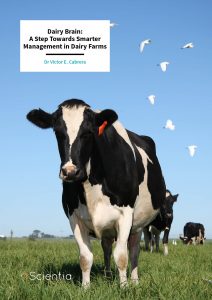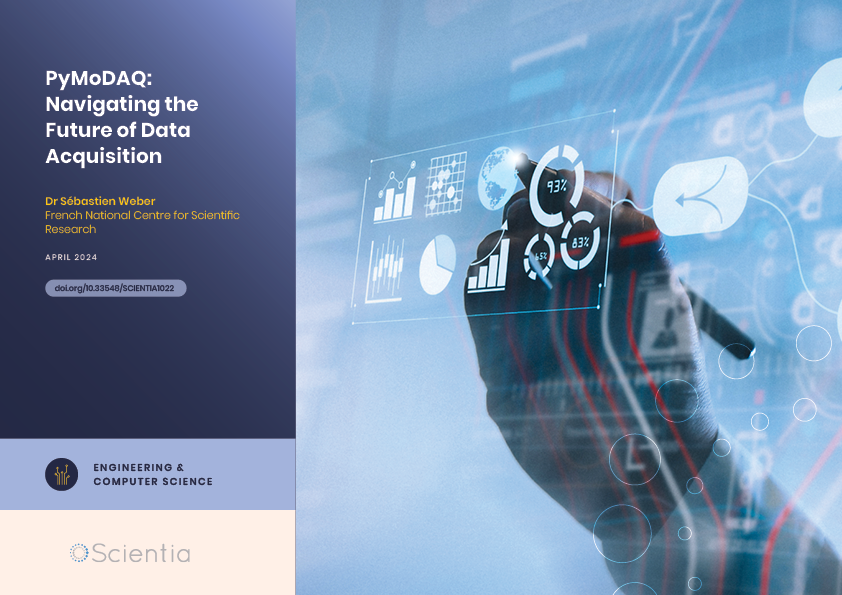Dr Victor E. Cabrera – Dairy Brain: A Step Towards Smarter Management in Dairy Farms
To manage their farms effectively, dairy farmers must base their decisions on real-time and continuous data streams, which collect information about feeding, milking, and an array of other factors. Dairy Brain is a toolkit introduced by Dr Victor E. Cabrera and his colleagues at the University of Wisconsin – Madison, which integrates the data streams collected by different software onto a single platform, and applies the latest algorithms to reveal novel insights. The technology could soon enable farmers and industry professionals to make far better use of the latest techniques in data analysis – and may even lead to new advances in efficiency and sustainability.
Modern Dairy Farming
Modern dairy farms produce and require vast amounts of data to operate. In order to optimise the efficiency of milk production, farmers must keep close track of various factors, including the nutritional requirements of their cows; the times at which they lactate; and the emergence of infections – all within herds containing thousands of animals.
In recent years, cutting-edge techniques have emerged that can handle these constant streams of data, containing diverse networks of sensors and robotic systems. These devices can be connected within the wider ‘Internet of Things’ (IoT), which allows the many interacting elements of dairy farms to freely exchange the data they need to operate efficiently. These innovations have led to a Big Data revolution in the dairy farming industry, and many farmers have come to fully embrace the technology.
Today, data collection techniques continue to evolve at an ever-growing pace. Their development has become a highly interdisciplinary field of research – involving farmers, data scientists, computer scientists, animal biologists, production management specialists, and industry professionals. However, this highly dynamic landscape is now presenting a new set of challenges.
Aiming for Integration
Currently, dairy farmers are finding it increasingly difficult to take full advantage of the opportunities presented by the latest data collection techniques. By collecting and analysing factors such as milking, feeding, reproduction, and cow behaviour, IoT systems can provide useful guidance for activities including nutritional management, selection of animals, and reproductive management.
Yet these systems could go one step further. Since these factors can be closely linked to each other, it would be highly beneficial to farmers to link multiple data streams together. In turn, farmers would be able to gather even more useful insights into what is happening on their farms, allowing them to further improve their management decisions. Unfortunately, however, this isn’t a simple task.
Within the IoT technologies often employed by modern dairy farms, data streams are typically visualised and interpreted separately, using different software tools. As a result, it can be incredibly difficult to link them together in real time when data streams are generated – despite the fact that they are closely interrelated. To overcome this challenge, researchers would need to develop a platform that can integrate all of the data streams collected on a farm. Through their research, Dr Victor E. Cabrera and his colleagues at the University of Wisconsin, Madison aim to reach this ambitious goal.
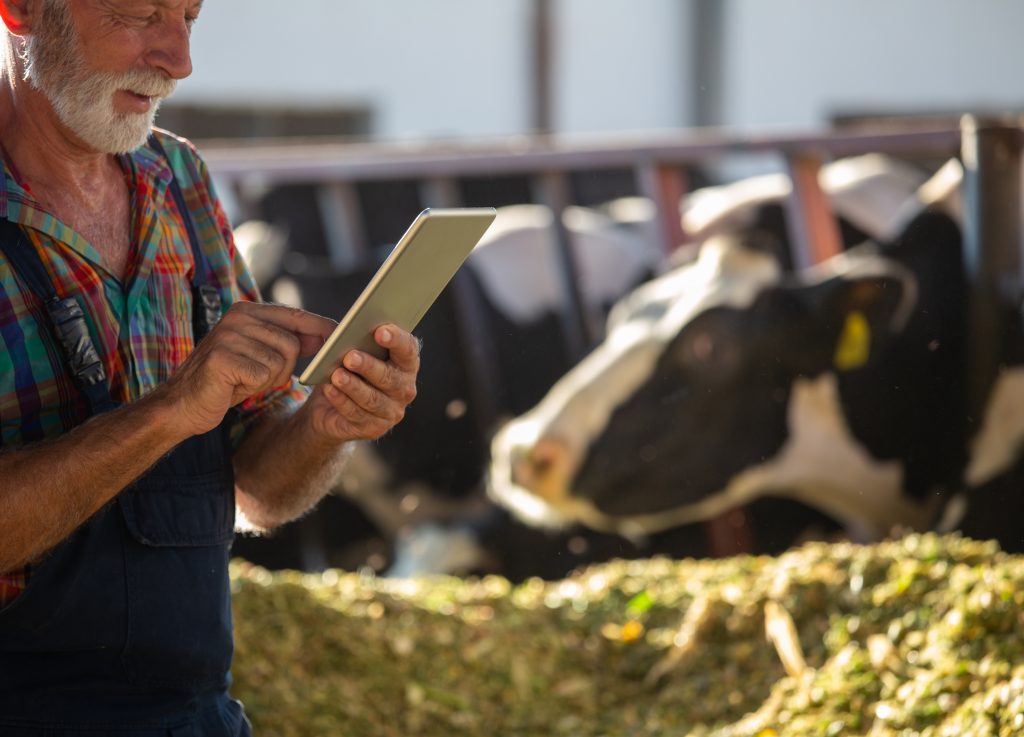
Developing a Smarter Platform
In 2019, Dr Cabrera’s team founded ‘UW-Dairy Brain’ – a platform that integrates all of the most important software involved in dairy farm management. The project now comprises a Coordinated Innovation Network (CIN) of over 100 researchers, industry professionals, farmers, and other stakeholders from across the globe, alongside a collaboration of several large data processors – all working closely with Dr Cabrera’s team at the University of Wisconsin. Now in its beta version, the technology incorporates a web-based interface, which allows users to access, integrate, and analyse multiple data streams.
Altogether, Dairy Brain operates by following five steps. Firstly, it transports the raw information from all relevant data streams into a centralised system. Then, it decodes and stores the information in a single database. Thirdly, Dairy Brain cleans the data to ensure that it can be used reliably; and then it expresses it in a uniform way, by identifying common features among the software used to collect each data stream. Finally, it integrates the data from these multiple different streams within a single location.
Each of these steps is crucial to make the data gathered from numerous different sources consistently available, and for developing new tools, capable of using this integrated data. So far, Dr Cabrera and his colleagues in the Dairy Brain, with the support of the CIN group, have examined the potential advantages of the platform in two particularly important applications.
Improving Nutritional Accuracy
To run their farms more efficiently, dairy farmers typically group their herds of lactating cows into pens. In doing this, their main concern is to keep management as simple as possible, by maintaining full pens, and producing the highest possible milk yield – all while minimising the amount of feed and nutrients the cows require in a group.
However, the nutritional requirements of different cows vary, depending on factors including their genetic makeup, stage of lactation, body weight, and whether or not they are pregnant. With inaccurate nutrition, some cows may become over- or under-fed – resulting in decreased productivity, and increased production costs.
To address these issues, more adequate approaches such as ‘nutritional grouping’ and ‘providing more accurate’ diets are now available. These techniques aim to better control costs and enhance efficiency on dairy farms, by collecting data on several different factors using specialised software, and using it to group cows into particular pens, depending on their nutritional requirements. In addition, they are able to formulate more accurate diets for each group of cows – all while respecting the unique practices of individual farms.
Despite these advantages, nutritional grouping has not been widely adopted by farmers. The problem is that an efficient platform has not yet been developed that can integrate the software required for each data stream – enabling farmers to deploy nutritional grouping within the unique constraints of their farms. Because of this, not all of the integrated data and algorithms required for the technique are available in a timely fashion, and many farmers believe that it adds unnecessary complexity to the management process.
By applying their Dairy Brain platform to the operation of actual farms in Wisconsin, Dr Cabrera’s team has revealed feasible methods for implementing the strategy. Firstly, Dairy Brain integrates real-time data streams gathered separately by milking, feeding, management, and diet formulation software. Then, it groups cows according to their nutritional requirements, while respecting farm factors – such as prioritising grouping first according to the amount of milk they produce and their stage of lactation.
Based on this information, the platform provides lists of cows with similar nutritional requirements and calculates the diets they need to provide to comply with the group nutritional requirements at the least cost.
This provides clear guidance for farmers as they split their herds into pens – allowing for better, simpler, and faster allocation of individual cows. Data from farms the team is working indicates that this strategy could reduce feeding costs by $31 per cow each year, which could amount to enormous savings and increased farm profitability.
Predicting Mastitis
Clinical mastitis is the most common disease experienced by dairy cows worldwide. It includes an inflammation in the udder tissue, which can be triggered by factors including physical trauma, overheating, and infection from microorganisms. In many cases, the condition will reduce milk quality and yield – but in the worst cases, it can prove fatal.
Although extensive research has now been done to prevent and treat mastitis, it still has a severe negative impact on dairy farm management. Through their latest research, Dr Cabrera’s team has approached the issue using Dairy Brain’s integrated data streams, again collected on actual Wisconsin farms.
In this case, Dairy Brain makes its predictions using machine learning – a form of artificial intelligence algorithms that can improve their performance through experience. Within the platform, data streams containing information about milking efficiency, genetics, and farm management are used to train the algorithms to make better predictions. Afterwards, real-time data streams can be used to reliably detect signs that are strongly associated with onset of mastitis – which may be virtually impossible for farmers to detect by themselves.
Altogether, the researchers ran two machine learning algorithms at the same time. The first of these allowed them to identify which particular cows are at higher risk of contracting mastitis during the first lactation. In the far shorter term, a second algorithm is able to predict when the risk of mastitis is imminent.
By including these two algorithms, the team hopes that Dairy Brain will provide a new dimension to health monitoring in herds – potentially detecting between 71 and 85% of all mastitis cases several milking sessions before the disease starts to take effect.
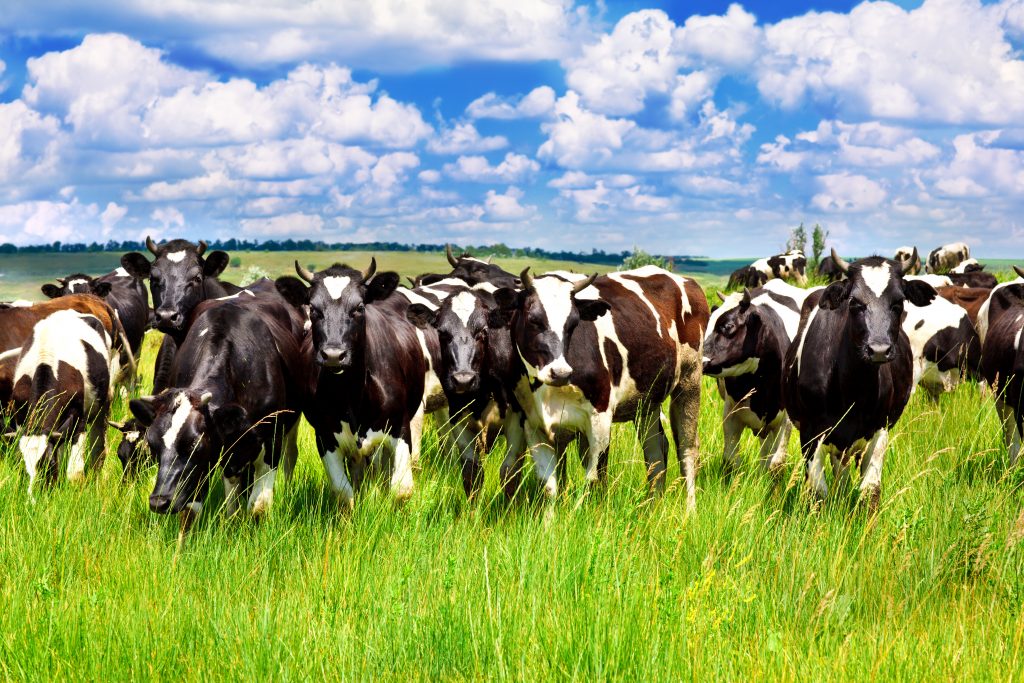
Success in Extensive Collaboration
Based on the success of these earlier studies, Dr Cabrera, together with his extensive team of collaborators within the Dairy Brain CIN, now hope to extend the capabilities of Dairy Brain even further. This will be made possible through extensive collaborations with a wide variety of researchers and organisations. As well as the US Council of Dairy Cattle Breeding, the team is working with data processors such as Valley Ag Software and Dairy Records Management Systems, to handle ever larger and more diverse datasets that will result in better decision making.
Together with Valley Ag Software and Bovisync, the researchers are also developing Dairy Brain’s web-based interface to better retrieve, connect, integrate, and efficiently use the data gathered by actual dairy farms. As part of the diverse and extensive network of researchers and industry professionals, the Dairy Brain CIN is now actively exploring several exciting lines of research.
Already, the network has been instrumental in developing and implementing a survey initiative, which questioned farmers and industry professionals on issues relating to data governance. Elsewhere, they have published five magazine articles about dairy farm data ecosystems on Hoard’s Dairyman and released a paper on decision support tools and another paper on data governance, and are now actively supporting other development aspects of the Dairy Brain platform.
Simulating Dairy Farms
Among these new projects is a collaboration between Dairy Brain and the ‘Ruminant Farm System’ (RuFaS) model national initiative, the next-generation, whole-farm model that simulates dairy farm production and environmental impact, which aims to provide the most rigorous tests yet for the Dairy Brain platform. So far, Dr Cabrera’s team has used farms to assess the technology’s performance. But in order to roll out the technology on larger scales, they will need to monitor thousands of farms over extensive periods of time – which would be far too expensive and time-consuming.
With the RuFaS interdisciplinary team, including researchers at Cornell, the University of Arkansas, University of California Davis, South Dakota State University and many USDA Agricultural Research Centres, Dr Cabrera and his colleagues are now collaborating in the development of this dairy farm simulator – in which the widely varying parameters of dairy farms can be carefully adjusted. When completed, the RuFaS model will allow researchers to accurately analyse the management of entirely virtual herds. Crucially, RuFaS will be flexible enough to simulate and evaluate the many different operations and practices that take place on different types of dairy farm and, importantly, to use integrated data coming from the Dairy Brain.
The RuFaS is centred around key modules that simulate production, economics, transformations, and losses of nutrients, carbon, and water, across all of the main working elements of a dairy farm. RuFaS will ultimately provide ideal opportunities for the Dairy Brain to test their platform, as it integrates the data streams gathered in a diverse array of differing scenarios. As a result, it will soon be an important toolkit for their upcoming research.
Future-proofing the Dairy Industry
Today, the dairy industry is coming under increasing pressure to reduce its carbon emissions, while simultaneously meeting an ever-growing demand for dairy products worldwide. In the coming years, cutting-edge techniques for improving the efficiency and sustainability of dairy farms will become ever more important; and it will be crucial for farmers to take full advantage of the latest techniques in data analysis.
By integrating real-time data streams and the extensive information they contain onto a single platform, Dr Cabrera and his CIN colleagues ultimately hope that Dairy Brain will provide the first clear route towards this goal – preparing the dairy industry for the monumental challenges it could face in the coming decades.
Acknowledgement
This Dairy Brain project is being supported by the Food and Agriculture Cyberinformatics and Tools grant no. 2019-68017-29935/project accession no. 1019780 from the USDA National Institute of Food and Agriculture.
SHARE
DOWNLOAD E-BOOK
REFERENCE
https://doi.org/10.33548/SCIENTIA758
MEET THE RESEARCHER

Dr Victor E. Cabrera
Department of Animal and Dairy Sciences
University of Wisconsin-Madison
Madison, WI
USA
Dr Victor Cabrera earned his PhD in Interdisciplinary Ecology at the University of Florida in 2004. He is now a Professor and Extension Specialist in Dairy Management at the University of Wisconsin-Madison, where his work includes the development of data-driven practical, user-friendly decision support tools for dairy farm management. Through these techniques, he aims to increase profits for dairy farms, while improving their long-term environmental sustainability. Dr Cabrera has received widespread recognition for his important work, including the Foundation Scholar Award in Dairy Production from the American Dairy Science Association, the DeLaval Dairy Extension Award and the Distinguished Achievement Award from the University of Florida School of Natural Resources and Environment.
CONTACT
E: vcabrera@wisc.edu
W: https://andysci.wisc.edu/directory/victor-cabrera/
W: https://dairybrain.wisc.edu/
W: https://en.wikipedia.org/wiki/Victor_E._Cabrera
FUNDING
University of Wisconsin-Madison USDA Hatch and McIntire-Stennis
USDA National Institute of Food and Agriculture, Food and Agriculture Cyberinformatics
USDA National Institute of Food and Agriculture, Inter-Disciplinary Engagement in Animal Systems
USDA National Institute of Food and Agriculture, Critical Agricultural Research and Extension
University of Wisconsin-Madison Graduate School Research Competition
USDA National Institute of Food and Agriculture, Sustainable Agricultural Systems
University of Wisconsin-Madison, Office of the Vice Chancellor for Research and Graduate Education, UW 2020 Initiative
USDA National Institute of Food and Agriculture, Organic Agriculture Research and Extension Initiative
USDA National Institute of Food and Agriculture, Agriculture Economics and Rural Communities
USDA National Institute of Food and Agriculture, Integrated Solutions for Animal Agriculture
USDA Risk and Management Education and Outreach Partnership Program, Competitive Cooperative Partnership Agreements
USDA National Institute of Food and Agriculture, North Central Risk Management and Education Center
FURTHER READING
SR Wangen, F Zhang, L Fadul-Pacheco, TE da Silva, VE Cabrera, Improving farm decisions: the application of data engineering techniques to manage data streams from contemporary dairy operations, Livestock Science, 2021, 104602.
R Cue, M Doornink, R George, B Griffiths, MW Jorgensen, R Rogers, A Saha, K Taysom, VE Cabrera, SR Wangen, L Fadul-Pacheco, Data Governance in the Dairy Industry, Animals, 2021, 11, 2981. https://doi.org/10.3390/ani11102981
L Fadul-Pacheco, H Delgado, VE Cabrera, Exploring machine learning algorithms for early prediction of clinical mastitis, International Dairy Journal, 2021, 119, 105051.
VE Cabrera, JA Barrientos-Blanco, H Delgado, L Fadul-Pacheco, Symposium review: Real-time continuous decision making using big data on dairy farms, Journal of dairy science, 2020, 103, 3856.
JA Barrientos-Blanco, H White, RD Shaver, VE Cabrera, Improving nutritional accuracy and economics through a multiple ration-grouping strategy, Journal of dairy science, 2020, 103, 3774.
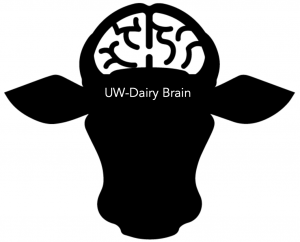
REPUBLISH OUR ARTICLES
We encourage all formats of sharing and republishing of our articles. Whether you want to host on your website, publication or blog, we welcome this. Find out more
Creative Commons Licence (CC BY 4.0)
This work is licensed under a Creative Commons Attribution 4.0 International License. 
What does this mean?
Share: You can copy and redistribute the material in any medium or format
Adapt: You can change, and build upon the material for any purpose, even commercially.
Credit: You must give appropriate credit, provide a link to the license, and indicate if changes were made.
SUBSCRIBE NOW
Follow Us
MORE ARTICLES YOU MAY LIKE
Professor Giorgio Buttazzo | Artificial Intelligence and a Crossroads for Humanity
Where do we stand with artificial intelligence? Might machines take over our jobs? Can machines become conscious? Might we be harmed by robots? What is the future of humanity? Professor Giorgio Buttazzo of Scuola Superiore Sant’Anna is an expert in artificial intelligence and neural networks. In a recent publication, he provides considered insights into some of the most pressing questions surrounding artificial intelligence and humanity.
Professor Martin Trefzer | Bridging Nature and Artificial Intelligence for Smart Electronics Technology
The ever-developing world of artificial intelligence (AI) stands at the tip of a transformative breakthrough. Professor Martin Trefzer from the University of York and Professor Jim Harkin from Ulster University have introduced a revolutionary approach to neural network design. They work on an electronic system based on AI that forms the basis of the cross-disciplinary project called Nervous Systems, which aims to build electronic neuromorphic devices with an artificial intelligence system mirroring the adaptability and responsiveness of biological neural systems.
Dr Jon Tore Lieng | Dynamically Installed Anchors for Floating Offshore Turbines
Effectively harnessing offshore wind presents a valuable opportunity to increase energy supplies. Floating wind turbines present several advantages over traditional fixed turbines in more shallow waters. Dr Jon Tore Lieng from Deep Sea Anchors and colleagues have developed a type of dynamically installed anchor to hold the structures in place while reducing both the costs and complexity associated with installation where cohesive seabed sediments are realised.
Dr Sébastien Weber | PyMoDAQ: Navigating the Future of Data Acquisition
In an era where data is paramount, Dr Sébastien Weber and his team at CNRS, the French National Centre for Scientific Research, are changing the landscape for scientists and engineers with PyMoDAQ, an open-source data acquisition software. Their revolutionary tool stands out for its accessibility, versatility, and the thriving community it fosters.

